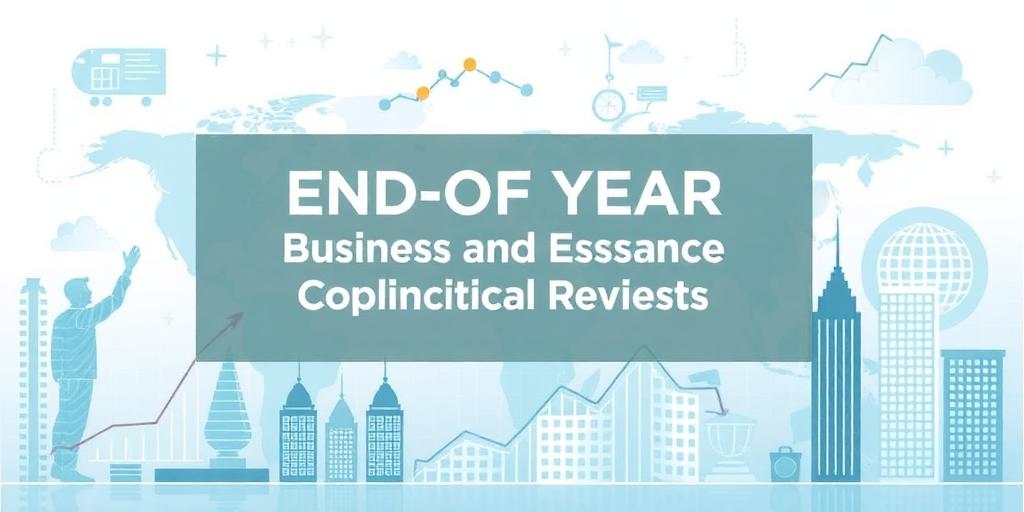End-of-Year Review: Business and Economy in 2025
As 2025 draws to a close, it's time to reflect on the key trends, challenges, and milestones that have shaped the business and economic landscape over the past year. This comprehensive review examines the major forces at play, providing insights into their impact and potential implications for the future.
Global Economic Performance
2025 witnessed moderate global economic growth, with varying performance across different regions. Developed economies experienced steady but unspectacular expansion, while emerging markets continued to be the primary drivers of growth. However, several factors have contributed to increased uncertainty, including geopolitical tensions, trade disputes, and inflationary pressures.
- Key Trends:
- Inflation Management: Central banks worldwide grappled with persistent inflation, implementing measures such as interest rate hikes and quantitative tightening to bring prices under control.
- Supply Chain Resilience: Efforts to diversify supply chains and enhance resilience gained momentum amid ongoing disruptions and geopolitical risks.
- Digital Transformation: Businesses across sectors accelerated their digital transformation initiatives, leveraging technologies like artificial intelligence, cloud computing, and automation to improve efficiency and competitiveness.
Sector-Specific Developments
- Technology: The tech sector continued to be a hotbed of innovation, with breakthroughs in areas such as quantum computing, biotechnology, and sustainable energy. However, increased regulatory scrutiny and concerns about data privacy posed challenges for tech companies.
- Finance: The financial industry navigated a complex landscape marked by rising interest rates, increased competition from fintech startups, and evolving regulatory requirements. Sustainability and ESG (Environmental, Social, and Governance) factors became increasingly important considerations for investors and businesses alike.
- Energy: The energy sector underwent significant transformation as the world transitions towards a more sustainable energy mix. Renewable energy sources such as solar, wind, and hydropower continued to gain market share, while investments in carbon capture and storage technologies increased.
- Manufacturing: The manufacturing sector faced challenges related to supply chain disruptions, labor shortages, and rising input costs. However, advancements in automation and additive manufacturing (3D printing) offered opportunities to improve productivity and reduce costs.
Policy and Regulation
Government policies and regulations played a crucial role in shaping the business and economic environment in 2025. Key developments include:
- Fiscal Stimulus: Many governments implemented fiscal stimulus measures to support economic recovery and mitigate the impact of the pandemic. However, concerns about rising debt levels and potential inflationary effects prompted a gradual shift towards fiscal consolidation.
- Trade Policies: Trade disputes and protectionist measures continued to pose challenges to global trade flows. Efforts to promote free trade and regional integration gained momentum, but significant obstacles remained.
- Environmental Regulations: Governments worldwide introduced stricter environmental regulations and incentives to promote sustainability and combat climate change. These measures have significant implications for businesses across sectors, driving investments in green technologies and sustainable practices.
Challenges and Opportunities
Looking ahead to 2026, businesses and economies will face a complex set of challenges and opportunities. Key considerations include:
- Geopolitical Risks: Rising geopolitical tensions and conflicts could disrupt trade flows, increase uncertainty, and undermine global economic stability. Businesses need to carefully assess and manage these risks.
- Technological Disruption: Rapid technological advancements will continue to disrupt industries and create new opportunities. Businesses must adapt to these changes and invest in innovation to remain competitive.
- Sustainability: The transition to a more sustainable economy presents both challenges and opportunities. Businesses that embrace sustainability and ESG principles will be better positioned to attract investors, customers, and talent.
Conclusion
2025 has been a year of significant change and uncertainty for the business and economy. While challenges remain, there are also opportunities for innovation, growth, and sustainable development. By understanding the key trends and forces at play, businesses and policymakers can make informed decisions and navigate the path ahead successfully.









